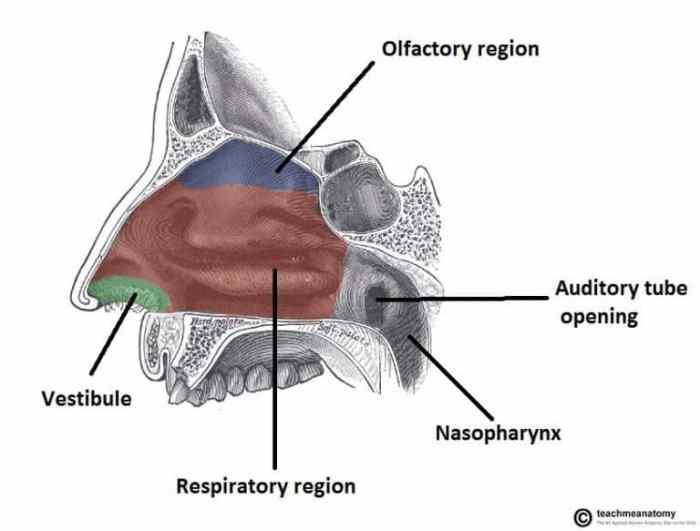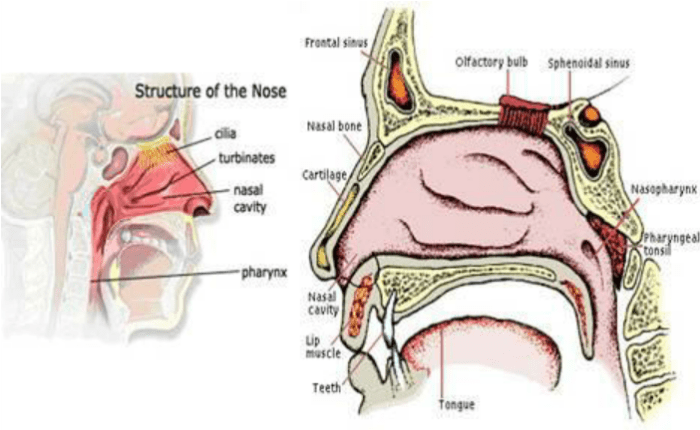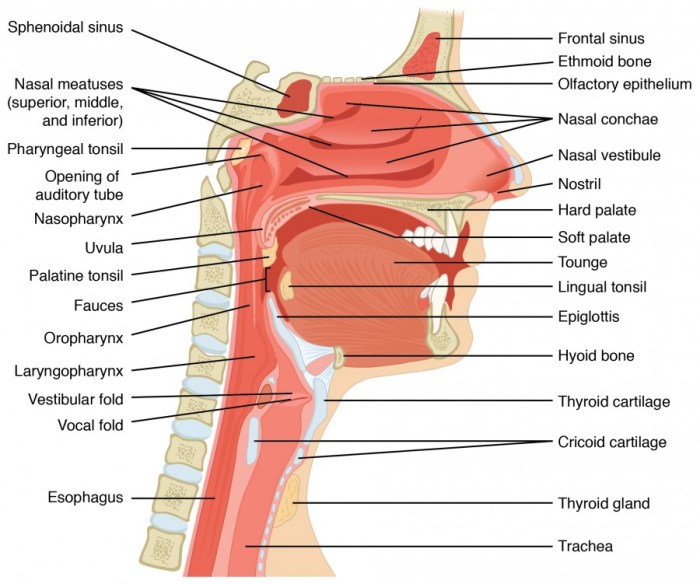Embarking on a journey into the intricacies of the nasal cavity, this guide unveils the diverse structures that reside within this intricate anatomical landscape. Label the structures of the nasal cavity, a crucial step in understanding its multifaceted functions, serves as the cornerstone of this exploration.
Delving deeper into the nasal cavity’s anatomy, we will dissect its boundaries, regions, and septum, providing a comprehensive understanding of its architecture. The major structures within this cavity, including the nasal conchae, sinuses, and nasolacrimal duct, will be meticulously examined, shedding light on their vital roles in maintaining respiratory and olfactory functions.
Anatomy of the Nasal Cavity

The nasal cavity is a large, air-filled space located within the skull. It is divided into two symmetrical halves by the nasal septum, a thin wall of cartilage and bone. The nasal cavity is bounded superiorly by the frontal bone, anteriorly by the nasal bones, inferiorly by the hard palate, and posteriorly by the sphenoid bone.The
nasal cavity can be divided into three regions: the vestibule, the respiratory region, and the olfactory region. The vestibule is the most anterior portion of the nasal cavity and is lined with skin. The respiratory region is the middle portion of the nasal cavity and is lined with mucous membrane.
The olfactory region is the most posterior portion of the nasal cavity and is lined with olfactory epithelium.
Structures of the Nasal Cavity, Label the structures of the nasal cavity
The nasal cavity contains a number of important structures, including:
- Nasal conchae (superior, middle, inferior): These are three pairs of bony projections that extend from the lateral wall of the nasal cavity. They increase the surface area of the nasal cavity and help to filter and warm the inhaled air.
- Ethmoid sinuses: These are air-filled cavities located within the ethmoid bone. They help to lighten the skull and resonate sound.
- Sphenoid sinuses: These are air-filled cavities located within the sphenoid bone. They help to lighten the skull and resonate sound.
- Frontal sinuses: These are air-filled cavities located within the frontal bone. They help to lighten the skull and resonate sound.
- Maxillary sinuses: These are air-filled cavities located within the maxillae. They help to lighten the skull and resonate sound.
- Nasolacrimal duct: This duct drains tears from the eyes into the nasal cavity.
Blood Supply and Innervation of the Nasal Cavity
The nasal cavity is supplied with blood by the maxillary artery and the facial artery. The maxillary artery is a branch of the external carotid artery and the facial artery is a branch of the common carotid artery.The nasal cavity is innervated by the olfactory nerve, the maxillary nerve, and the mandibular nerve.
The olfactory nerve is responsible for the sense of smell, the maxillary nerve is responsible for sensation in the upper teeth and gums, and the mandibular nerve is responsible for sensation in the lower teeth and gums.
Functions of the Nasal Cavity
The nasal cavity has a number of important functions, including:
- Filtration and warming of inhaled air: The nasal cavity helps to filter out dust, pollen, and other particles from the inhaled air. It also helps to warm the inhaled air, which is important for protecting the lungs.
- Olfaction (sense of smell): The nasal cavity is responsible for the sense of smell. The olfactory epithelium is located in the olfactory region of the nasal cavity and contains olfactory receptors that can detect odor molecules.
- Humidification of inhaled air: The nasal cavity helps to humidify the inhaled air, which is important for protecting the lungs.
Clinical Significance of the Nasal Cavity
The nasal cavity is a common site of infection and inflammation. Rhinitis is an inflammation of the nasal mucosa and can be caused by allergies, viruses, or bacteria. Sinusitis is an inflammation of the paranasal sinuses and can be caused by bacteria or viruses.
Nasal polyps are benign growths in the nasal cavity that can block the nasal passages.The nasal cavity can also be affected by a number of other conditions, including:
- Nasal septum deviation: This is a condition in which the nasal septum is deviated to one side, which can block the nasal passages.
- Nasal turbinate hypertrophy: This is a condition in which the nasal turbinates are enlarged, which can block the nasal passages.
- Nasal trauma: This is a condition in which the nasal cavity is injured, which can cause bleeding, pain, and swelling.
FAQ Insights: Label The Structures Of The Nasal Cavity
What is the function of the nasal conchae?
The nasal conchae are turbinate bones that increase the surface area of the nasal cavity, promoting airflow turbulence and maximizing air conditioning.
How many sinuses are associated with the nasal cavity?
There are four pairs of sinuses associated with the nasal cavity: frontal, ethmoid, maxillary, and sphenoid sinuses.
What is the role of the nasolacrimal duct?
The nasolacrimal duct drains tears from the eyes into the nasal cavity.


